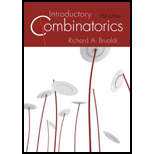Solutions for Introductory Combinatorics
Problem 3E:
Prove the following about the Fibonacci numbers:
fn is even if and only if n is divisible by 3.
fn...Problem 4E:
4. Prove that the Fibonacci sequence is the solution of the recurrence relation
an = 5an − 4 + 3an −...Problem 5E:
By examining the Fibonacci sequence, make a conjecture about when fn is divisible by 7 and then...Problem 6E:
* Let m and n be positive integers. Prove that if m is divisible by n, then fm is divisible by fn.
Problem 7E:
* Let m and n be positive integers whose greatest common divisor is d. Prove that the greatest...Problem 8E:
Consider a 1-by-n chessboard. Suppose we color each square of the chessboard with one of the two...Problem 13E:
13. Determine the generating function for each of the following sequences:
c0 =1, c, c2 ,⋯ , cn,...Problem 14E:
14. Let S be the multiset {∞ · e1, ∞ · e2, ∞ · e3, ∞ · e4}. Determine the generating function for...Problem 16E:
16. Formulate a combinatorial problem for which the generating function is
(1 + x + x2)(1 + x2 + x4...Problem 17E:
17. Determine the generating function for the number hn of bags of fruit of apples, oranges,...Problem 18E:
18. Determine the generating function for the number hn of nonnegative integral solutions of
2e1 +...Problem 19E:
19. Let h0, h1, h2, …, hn, … be the sequence defined by , (n ≥ 0). Determine the generating function...Problem 21E:
21. * Let hn denote the number of regions into which a convex polygonal region with n + 2 sides is...Problem 22E:
22. Determine the exponential generating function for the sequence of factorials: 0!, 1!, 2!, 3!, …,...Problem 23E:
23. Let α be a real number. Let the sequence h0, h1, h2, …, hn,… be defined by h0 = 1, and hn = α(α...Problem 24E:
24. Let S be the multiset {∞ · e1, ∞ · e2, · , ∞ · ek}. Determine the exponential generating...Problem 25E:
25. Let hn denote the number of ways to color the squares of a 1-by-n board with the colors red,...Problem 26E:
Determine the number of ways to color the squares of a 1-by-n chessboard, using the colors red,...Problem 27E:
Determine the number of n-digit numbers with all digits odd, such that 1 and 3 each occur a nonzero,...Problem 28E:
Determine the number of n-digit numbers with all digits at least 4, such that 4 and 6 each occur an...Problem 29E:
We have used exponential generating functions to show that the number hn of n-digit numbers with...Problem 31E:
Solve the recurrence relation hn = 4hn−2, (n ≥ 2) with initial values h0 = 0 and h1 = 1.
Problem 33E:
Solve the recurrence relation hn = hn−1 + 9hn−2 − 9hn−3, (n ≥ 3) with initial values h0 = 0, h1 = 1,...Problem 34E:
Solve the recurrence relation hn = 8hn−1 − 16hn−2, (n ≥ 2) with initial values h0 = −1 and h1 = 0.
Problem 35E:
Solve the recurrence relation hn = 3hn − 2 − 2hn − 3 , (n ≥ 3) with initial values h0 = 1, h1 = 0,...Problem 37E:
Determine a recurrence relation for the number an of ternary strings (made up of 0s, 1s, and 2s) of...Problem 39E:
Let hn denote the number of ways to perfectly cover a 1-by-n board with monominoes and dominoes in...Problem 40E:
Let an equal the number of ternary strings of length n made up of 0s, 1s, and 2s, such that the...Problem 41E:
* Let 2n equally spaced points be chosen on a circle. Let hn denote the number of ways to join these...Problem 42E:
Solve the nonhomogeneous recurrence relation
Problem 44E:
Solve the nonhomogeneous recurrence relation
Problem 46E:
Solve the nonhomogeneous recurrence relation
Problem 47E:
Solve the nonhomogeneous recurrence relation
Problem 48E:
Solve the following recurrence relations by using the method of generating functions as described in...Problem 49E:
(q-binomial theorem) Prove that
where
is the q-factorial (cf. Theorem 7.2.1 replacing q in (7.14)...Browse All Chapters of This Textbook
Chapter 1 - What Is Combinatorics?Chapter 2 - Permutations And CombinationsChapter 3 - The Pigeonhole PrincipleChapter 4 - Generating Permutations And CombinationsChapter 5 - The Binomial CoefficientsChapter 6 - The Inclusion-exclusion Principle And ApplicationsChapter 7 - Recurrence Relations And Generating FunctionsChapter 8 - Special Counting SequencesChapter 9 - Systems Of Distinct RepresentativesChapter 10 - Combinatorial Designs
Sample Solutions for this Textbook
We offer sample solutions for Introductory Combinatorics homework problems. See examples below:
To show this, we have to add 3 cases here. Case 1: Assume that one of m and n is even and the second...Procedure used: Multiplication principle: When a task has p outcomes and, no matter what the outcome...Given: The cumulative number of games played on the first n days is denoted by an, where n=1,2,…,77....Algorithm used: Begin with 1←,2←,⋯,n←. While there exists a mobile integer, do the following: (1)...Formula used: The pascal’s triangle formula is: (nk)=n!k!(n−k)!=n(n−1)⋅⋅⋅(n−k+1)k(k−1)⋅⋅⋅1...Suppose the set S={1,2,...,104}. Let A, B, C be the set of integers S that are divisible by 4, 5, 6...Using the mathematical induction and the Fibonacci recurrence. The sequence of numbers...Chapter 8, Problem 1EDefinition used: Let Y be a finite set and A=(A1,A2,…,An) be a family of n subsets of Y. A family...
Definition used: “Let n be a positive integer with n≥2, then Zn={0,1,…,n−1}.” “For any two integers...Definition used: “Two general graphs G=(V,E) and G=(V′,E′) are called isomorphic, provided that...Definition used: Chromatic number: Let G=(V,E) be a graph. A vertex coloring of G is an assignment...The given permutations are, f=(123456642153) and g=(123456356241). Here, (f∘g)(1)=2, (f∘g)(2)=5,...
More Editions of This Book
Corresponding editions of this textbook are also available below:
Related Math Textbooks with Solutions
Still sussing out bartleby
Check out a sample textbook solution.
